Optimal Sowing Windows under Rainfall Variability in Rainfed Agriculture in West Africa
Abstract
:1. Introduction
2. Data Description
2.1. Study Area
2.2. Data Sources
| Mean | Mean | |||||
|---|---|---|---|---|---|---|
| ID | Stations | Coordinates | Country | (mm) | (mm) | Period |
| Bog | Bogande | 12.98 N; 0.16 W | Burkina Faso | 488.7 | 1253.3 | 2017–2019 |
| Bor | Boromo | 11.74 N; 2.93 W | Burkina Faso | 1013.4 | 1252.1 | 2018–2020 |
| Daf | Daffiama | 10.42 N; 2.55 W | Ghana | 795.7 | 1287.2 | 2018–2020 |
| Ded | Dedougou | 12.46 N; 3.48 W | Burkina Faso | 920.2 | 1205.1 | 2017–2020 |
| Dor | Dori | 14.03 N; 0.07 W | Burkina Faso | 438 | 1349.3 | 2017–2020 |
| Far | Fari | 12.16 N; 10.67 W | Mali | 984 | 1127 | 2018–2020 |
| Fin | Finkoloni | 12.26 N; 5.49 W | Mali | 970.8 | 1499 | 2017, 2019–2020 |
| Gao | Gaoua | 10.39 N; 3.17 W | Burkina Faso | 1101.5 | 1280 | 2017–2020 |
| Kou | Kourounikoto | 13.85 N; 9.58 W | Mali | 989 | 1276 | 2018–2020 |
| Man | Mandouri | 10.86 N; 0.79 W | Togo | 613 | 1050.4 | 2018–2020 |
| Oua | Ouahigouya | 13.57 N; 2.42 W | Burkina Faso | 984 | 1282.2 | 2017–2020 |
| Ous | Oussoubidiagna | 14.25 N; 10.46 W | Mali | 619 | 1185 | 2018–2020 |
| Po | Po | 11.18 N; 1.4 W | Burkina Faso | 1264.7 | 1159.8 | 2017–2020 |
| Pus | Pusiga | 11.07 N; 0.11 W | Ghana | 1226.8 | 1155.3 | 2018–2020 |
| Sel | Selingue | 11.65 N; 8.21 W | Mali | 478.4 | 1220.2 | 2018–2020 |
| Sir | Sirakoro | 12.68 N; 9.23 W | Mali | 987.1 | 1110.4 | 2018–2020 |
| Som | Somo | 13.24 N; 4.78 W | Mali | 487.1 | 1532.1 | 2017, 2019–2020 |
| Tam | Tamale | 9.50 N; 1.00 W | Ghana | 588.9 | 1205.1 | 2019–2020 |
| Tan | Tanguieta | 10.63 N; 1.27 E | Benin | 980.7 | 1070.5 | 2017–2020 |
| Uni | Unimaid | 11.81 N; 13.21 E | Nigeria | 503.8 | 1315 | 2016–2017, 2020 |
2.3. Seasonal Variability of Rainfall and Evaporation in the Study Region
2.4. Dry Spells during the Growing Season
3. Methods
3.1. Definitions of the Onset of the Rainy Season for Agriculture
3.2. The FAO Crop Model, AquaCrop
3.2.1. Description of the Model
3.2.2. Parameterization of the Model
4. Results and Discussion
4.1. Crop Model Performance
4.2. Yield Distribution in Response to Varying Sowing Dates
4.3. Comparing Yield Response for Three Local Onset Approaches
4.4. Effects of Water Stress on Crop Development
4.5. Safe Sowing Window across West Africa
5. Conclusions
Author Contributions
Funding
Informed Consent Statement
Data Availability Statement
Acknowledgments
Conflicts of Interest
Appendix A. Variation of the Yield Response of 90-Day Maize
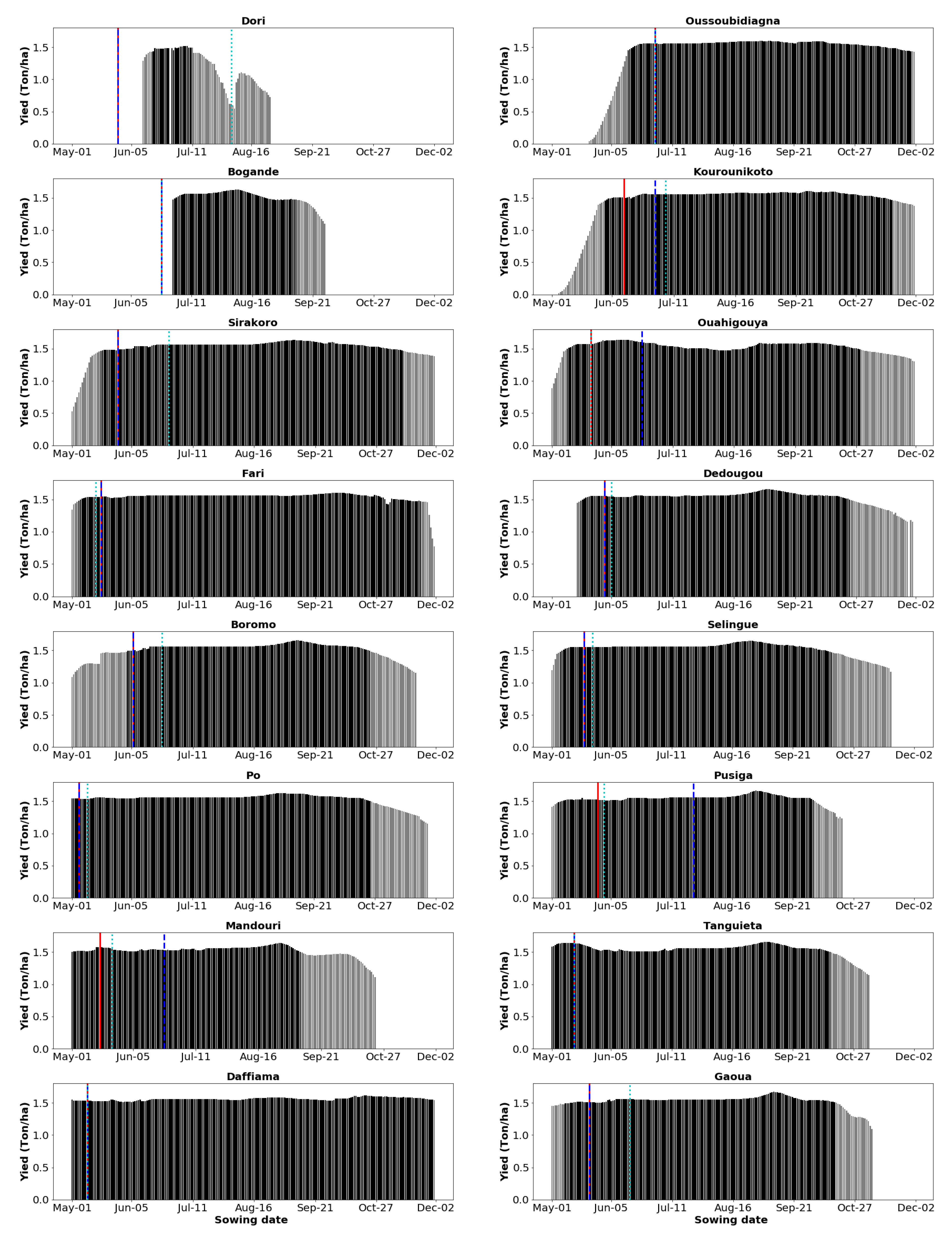
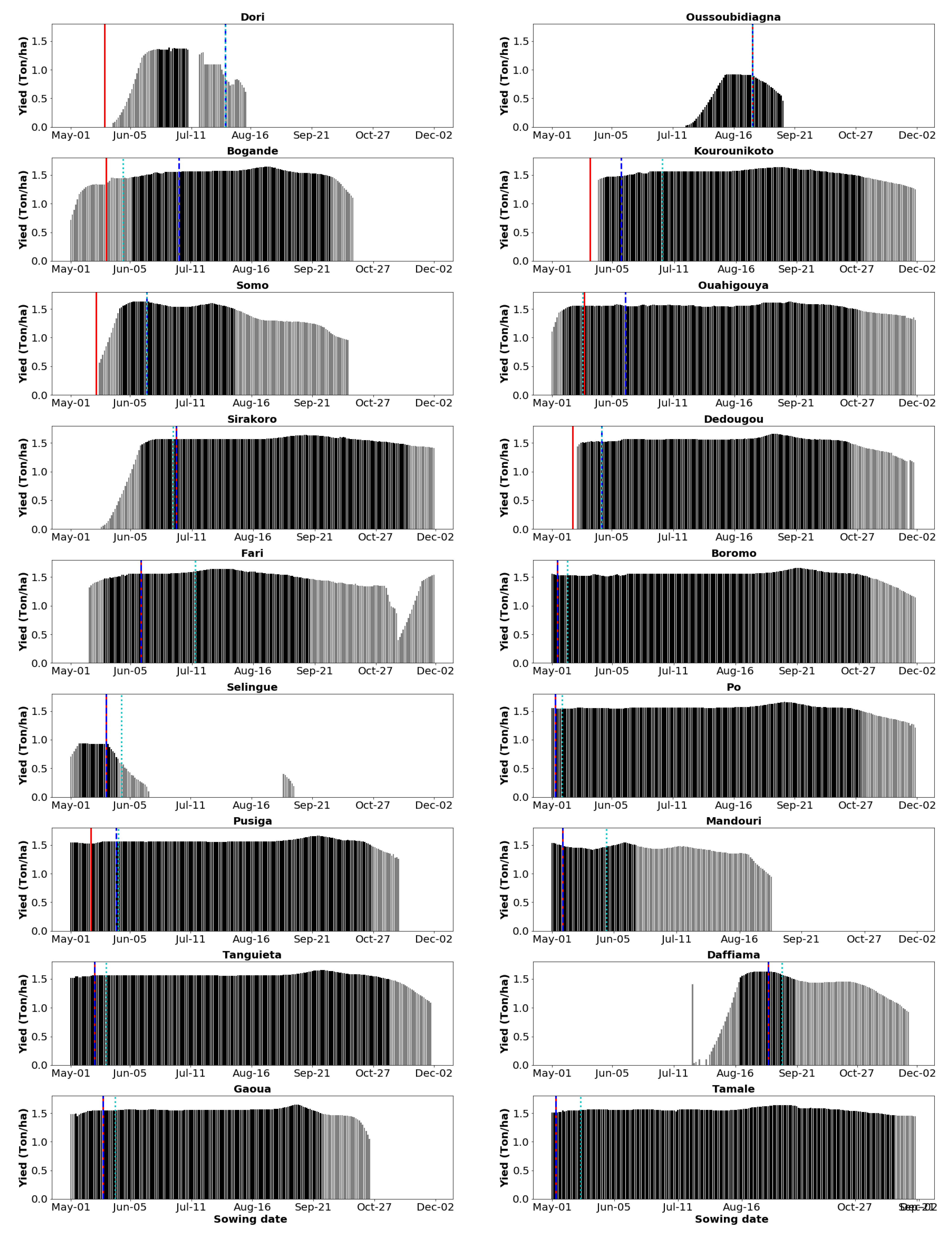
References
- Berners-Lee, M.; Kennelly, C.; Watson, R.; Hewitt, C.N. Current global food production is sufficient to meet human nutritional needs in 2050 provided there is radical societal adaptation. Elem. Sci. Anthr. 2018, 6, 52. [Google Scholar] [CrossRef]
- FAO; IFAD; UNICEF; WFP; WHO. The State of Food Security and Nutrition in the World 2022. Repurposing Food and Agricultural Policies to Make Healthy Diets More Affordable; Food and Agriculture Organization of the United Nations: Rome, Italy, 2022; p. 260. [Google Scholar] [CrossRef]
- Gbangou, T.; Ludwig, F.; van Slobbe, E.; Hoang, L.; Kranjac-Berisavljevic, G. Seasonal variability and predictability of agro-meteorological indices: Tailoring onset of rainy season estimation to meet farmers’ needs in Ghana. Clim. Serv. 2019, 14, 19–30. [Google Scholar] [CrossRef]
- Froidurot, S.; Diedhiou, A. Characteristics of wet and dry spells in the West African monsoon system. Atmos. Sci. Let. 2017, 18, 125–131. [Google Scholar] [CrossRef]
- Rockström, J.; Karlberg, L.; Wani, S.P.; Barron, J.; Hatibu, N.; Oweis, T.; Bruggeman, A.; Farahani, J.; Qiang, Z. Managing water in rainfed agriculture—The need for a paradigm shift. Agric. Water Manag. 2010, 97, 543–550. [Google Scholar] [CrossRef] [Green Version]
- Gaetani, M.; Janicot, S.; Vrac, M.; Famien, A.M.; Sultan, B. Robust assessment of the time of emergence of precipitation change in West Africa. Sci. Rep. 2020, 10, 7670. [Google Scholar] [CrossRef]
- Sultan, B.; Guan, K.; Kouressy, M.; Biasutti, M.; Piani, C.; Hammer, G.L.; McLean, G.; Lobell, D.B. Robust features of future climate change impacts on sorghum yields in West Africa. Environ. Res. Lett. 2014, 9, 104006. [Google Scholar] [CrossRef]
- Guilpart, N.; Grassini, P.; van Wart, J.; Yang, H.; van Ittersum, M.; van Bussel, L.G.J.; Wolf, J.; Claessens, L.; Leenaars, J.G.; Cassman, K. Rooting for food security in Sub-Saharan Africa. Environ. Res. Lett. 2017, 12, 114036. [Google Scholar] [CrossRef]
- Gbangou, T.; Slobbe, E.V.; Ludwig, F.; Kranjac-Berisavljevic, G.; Paparrizos, S. Harnessing Local Forecasting Knowledge on Weather and Climate in Ghana: Documentation, Skills, and Integration with Scientific Forecasting Knowledge. Weather Clim. Soc. 2020, 13, 23–37. [Google Scholar] [CrossRef]
- Laux, P.; Kunstmann, H.; Bardossy, A. Predicting the regional onset of the rainy season in West Africa. Int. J. Climatol. 2008, 28, 329–342. [Google Scholar] [CrossRef]
- Silungwe, F.R.; Graef, F.; Bellingrath-Kimura, S.D.; Tumbo, S.D.; Kahimba, F.C.; Lana, M.A. The Management Strategies of Pearl Millet Farmers to Cope with Seasonal Rainfall Variability in a Semi-Arid Agroclimate. Agronomy 2019, 9, 400. [Google Scholar] [CrossRef] [Green Version]
- Fontaine, B.; Louvet, S.; Roucou, P. Definition and predictability of an OLR-based West African monsoon onset. Int. J. Climatol. 2008, 28, 1787–1798. [Google Scholar] [CrossRef] [Green Version]
- Gazeaux, J.; Flaounas, E.; Naveau, P.; Hannart, A. Inferring change points and nonlinear trends in multivariate time series: Application to West African monsoon onset timings estimation. J. Geophys. Res. 2011, 116, D05101. [Google Scholar] [CrossRef] [Green Version]
- Ati, O.; Stigter, C.; Oladipo, E. A comparison of methods to determine the onset of the growing season in Northern Nigeria. Int. J. Climatol. 2002, 22, 731–742. [Google Scholar] [CrossRef]
- Marteau, R.; Moron, V.; Philippon, N. Spatial coherence of monsoon onset over Western and Central Sahel (1950–2000). J. Clim. 2009, 22, 1313–1324. [Google Scholar] [CrossRef] [Green Version]
- Yamada, T.J.; Kanae, S.; Oki, T.; Koster, R.D. Seasonal variation of land–atmosphere coupling strength over the West African monsoon region in an atmospheric general circulation model. Hydrol. Sci. J. 2013, 58, 1276–1286. [Google Scholar] [CrossRef]
- Sultan, B.; Baron, C.; Dingkuhn, M.; Sarr, B.; Janicot, S. Agricultural impacts of large-scale variability of the West African monsoon. Agric. For. Meteor. 2005, 128, 93–110. [Google Scholar] [CrossRef]
- Ismaila, U.; Gana, A.S.; Tswanya, N.M.; Dogara, D. Cereals production in Nigeria: Problems, constraints and opportunities for betterment. Afr. J. Agric. Res. 2010, 5, 1341–1350. [Google Scholar] [CrossRef]
- Aryee, J.; Amekudzi, L.; Quansah, E.; Klutse, N.; Atiah, W.; Yorke, C. Development of high spatial resolution rainfall data for Ghana. Int. J. Climatol. 2018, 38, 1201–1215. [Google Scholar] [CrossRef]
- Lebel, T.; Ali, A. Recent trends in the Central and Western Sahel rainfall regime (1990–2007). J. Hydrol. 2009, 375, 52–64. [Google Scholar] [CrossRef]
- van de Giesen, N.; Hut, R.; Selker, J. The Trans-African Hydro-Meteorological Observatory (TAHMO). WIREs Water 2014, 1, 341–348. [Google Scholar] [CrossRef] [Green Version]
- Jones, A.; Breuning-Madsen, H.; Brossard, M.; Dampha, A.; Deckers, J.; Dewitte, O.; Gallali, T.; Hallett, S.; Jones, R.; Kilasara, M.; et al. Soil Atlas of Africa, 66th ed.; FAO Irrigation and Drainage Paper, European Commission, Publications Office of the European Union: Luxembourg, 2013; p. 176. [Google Scholar]
- Saxton, K.; Rawls, W. Soil water characteristic estimates by texture and organic matter for hydrologic solutions. Soil Sci. Soc. Am. J. 2006, 70, 1569–1578. [Google Scholar] [CrossRef] [Green Version]
- de Bruin, H.A.R.; Lablans, W.N. Reference crop evapotranspiration determined with a modified Makkink equation. Hydrol. Process. 1998, 12, 1053–1062. [Google Scholar] [CrossRef]
- Sivakumar, M.V.K. Empirical analysis of dry spells for agricultural applications in West Africa. J. Clim. 1992, 5, 532–539. [Google Scholar] [CrossRef]
- Nyadzi, E. BEST OF BOTH WORLDS: Co-Producing Climate Services that Integrate Scientific and Indigenous Weather and Seasonal Climate Forecast for Water Management and Food Production in Ghana. Ph.D. Thesis, Wageningen University and Research, Wageningen, The Netherlands, 2020. [Google Scholar]
- Fitzpatrick, R.G.J.; Bain, C.L.; Knippertz, P.; Marsham, J.; Parker, D.J. The West African Monsoon Onset: A Concise Comparison of Definitions. J. Clim. 2015, 28, 8673–8694. [Google Scholar] [CrossRef]
- Marteau, R.; Sultan, B.; Moron, V.; Alhassane, A.; Baron, C.; Traoré, S.B. The onset of the rainy season and farmers’ sowing strategy for pearl millet cultivation in Southwest Niger. Agric. For. Meteorol. 2011, 151, 1356–1369. [Google Scholar] [CrossRef] [Green Version]
- Huho, J.M. Rain-fed agriculture and climate change: An analysis of the most appropriate planting dates in Central Division of Laikipia District, Kenya. Int. J. Curr. Res. 2011, 3, 172–182. [Google Scholar]
- Steduto, P.; Hsiao, T.C.; Raes, D.; Fereres, E. AquaCrop—The FAO crop model to simulate yield response to water: I. Concepts and underlying principles. Agron. J. 2009, 101, 426–437. [Google Scholar] [CrossRef] [Green Version]
- Vanuytrecht, E.; Raes, D.; Steduto, P.; Hsiao, T.C.; Fereres, E.; Heng, L.K.; García-Vila, M.; Moreno, P.M. AquaCrop: FAO’s crop water productivity and yield response model. Environ. Model. Softw. 2014, 62, 351–360. [Google Scholar] [CrossRef]
- Hsiao, T.; Heng, L.; Steduto, P.; Rojas-Lara, B.; Raes, D.; Fereres, E. AquaCrop—The FAO Crop Model to Simulate Yield Response to Water: III. Parameterization and Testing for Maize. Agron. J. 2009, 101, 448–459. [Google Scholar] [CrossRef]
- Abedinpour, M.; Sarangi, A.; Rajput, T.; Singh, M.; Pathak, H.; Ahmad, T. Performance evaluation of AquaCrop model for maize crop in a semi-arid environment. Agric. Water Manag. 2012, 110, 55–66. [Google Scholar] [CrossRef]
- Raes, D.; Steduto, P.; Hsiao, T.C.; Fereres, E. AquaCrop—The FAO crop model to simulate yield response to water: II. Main algorithms and software description. Agron. J. 2009, 101, 438–447. [Google Scholar] [CrossRef] [Green Version]
- Akumaga, U.; Tarhule, A.; Yusuf, A.A. Validation and testing of the FAO AquaCrop model under different levels of nitrogen fertilizer on rain-fed maize in Nigeria, West Africa. Agric. For. Meteorol. 2017, 232, 225–234. [Google Scholar] [CrossRef]
- Ran, H.; Kang, S.; Li, F.; Du, T.; Tong, L.; Li, S.; Ding, R.; Zhang, X. Parameterization of the AquaCrop model for full and deficit irrigated maize for seed production in arid Northwest China. Agric. Water Manag. 2018, 203, 438–450. [Google Scholar] [CrossRef]
- Raes, D.; Steduto, P.; Hsiao, T.C.; Fereres, E. AquaCrop Version 6.0–6.1, Reference Manual; Food and Agriculture Organization of the United Nations: Rome, Italy, 2018. [Google Scholar]
- Nyakudya, I.W.; Stroosnijder, L. Effect of rooting depth, plant density and planting date on maize (Zea mays L.) yield and water use efficiency in semi-arid Zimbabwe: Modelling with AquaCrop. Agric. Water Manag. 2014, 146, 280–296. [Google Scholar] [CrossRef]
- MoFA. Agriculture in Ghana: Facts and Figures; Ministry of Food and Agriculture, Statistics, Research, and Information Directorate (SRID): Accra, Ghana, 2010.
- Galford, G.L.; Peña, O.; Sullivan, A.K.; Nash, J.; Gurwick, N.; Pirolli, G.; Richards, M.; White, J.; Wollenberg, E. Agricultural development addresses food loss and waste while reducing greenhouse gas emissions. Sci. Total Environ. 2020, 699, 134318. [Google Scholar] [CrossRef]
- Shelia, V.; Gummadi, S.; Nenkam, A.; Sibiry Traore, P.C.; Hansen, J.W.; Whitbread, A.; Hoogenboom, G. Spatial Multi-Model Regional Yield Simulations Using the Ccafs Regional Agricultural Forecasting Toolbox (CRAFT): A Case Study for Mali. In Proceedings of the ASA, CSSA, and CSA International Annual Meeting, Baltimore, MD, USA, 4–7 November 2018. [Google Scholar]
- Abate, T.; Coulibaly, N.; Menkir, A.; Wawa, B. DT Maize: A Quarterly Bulletin of the Drought Tolerant Maize for Africa Project. CIMMYT and IITA Report, Volume 4, No. 1, March 2015. Available online: https://bit.ly/3BUkljG (accessed on 20 July 2022).
- Tittonell, P.; Giller, K.E. When yield gaps are poverty traps: The paradigm of ecological intensification in African smallholder agriculture. Field Crop. Res. 2013, 143, 76–90. [Google Scholar] [CrossRef] [Green Version]
- Wolka, K.; Mulder, J.; Biazin, B. Effects of soil and water conservation techniques on crop yield, runoff and soil loss in Sub-Saharan Africa: A review. Agric. Water Manag. 2018, 207, 67–79. [Google Scholar] [CrossRef]
- Waongo, M.; Laux, P.; Traoré, S.B.; Sanon, M.; Kunstmann, H. A Crop Model and Fuzzy Rule Based Approach for Optimizing Maize Planting Dates in Burkina Faso, West Africa. J. Appl. Meteorol. Climatol. 2014, 53, 598–613. [Google Scholar] [CrossRef]
- Benoit, P. The start of the growing season in Northern Nigeria. Agric. Meteorol. 1977, 18, 91–99. [Google Scholar] [CrossRef]

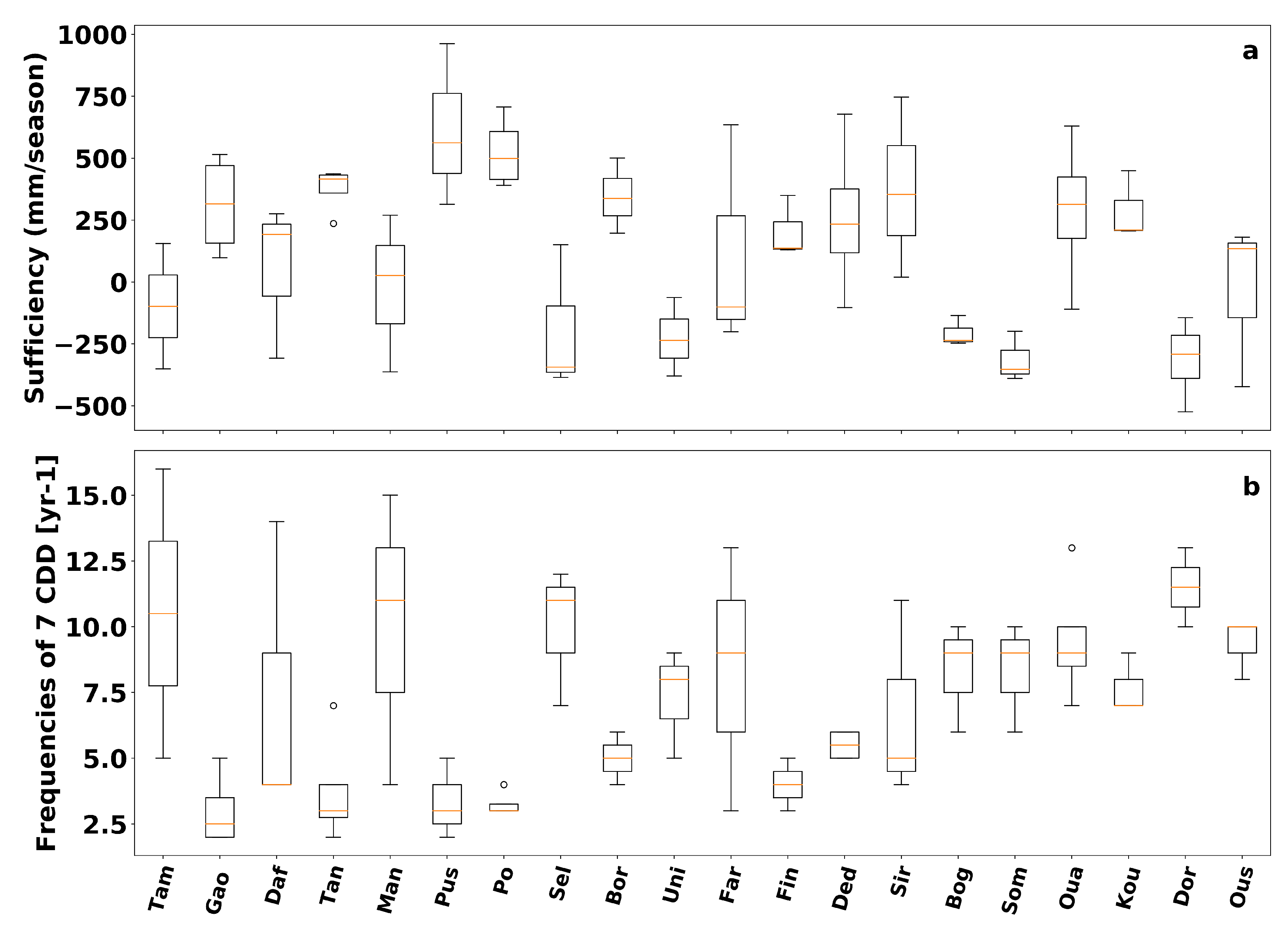


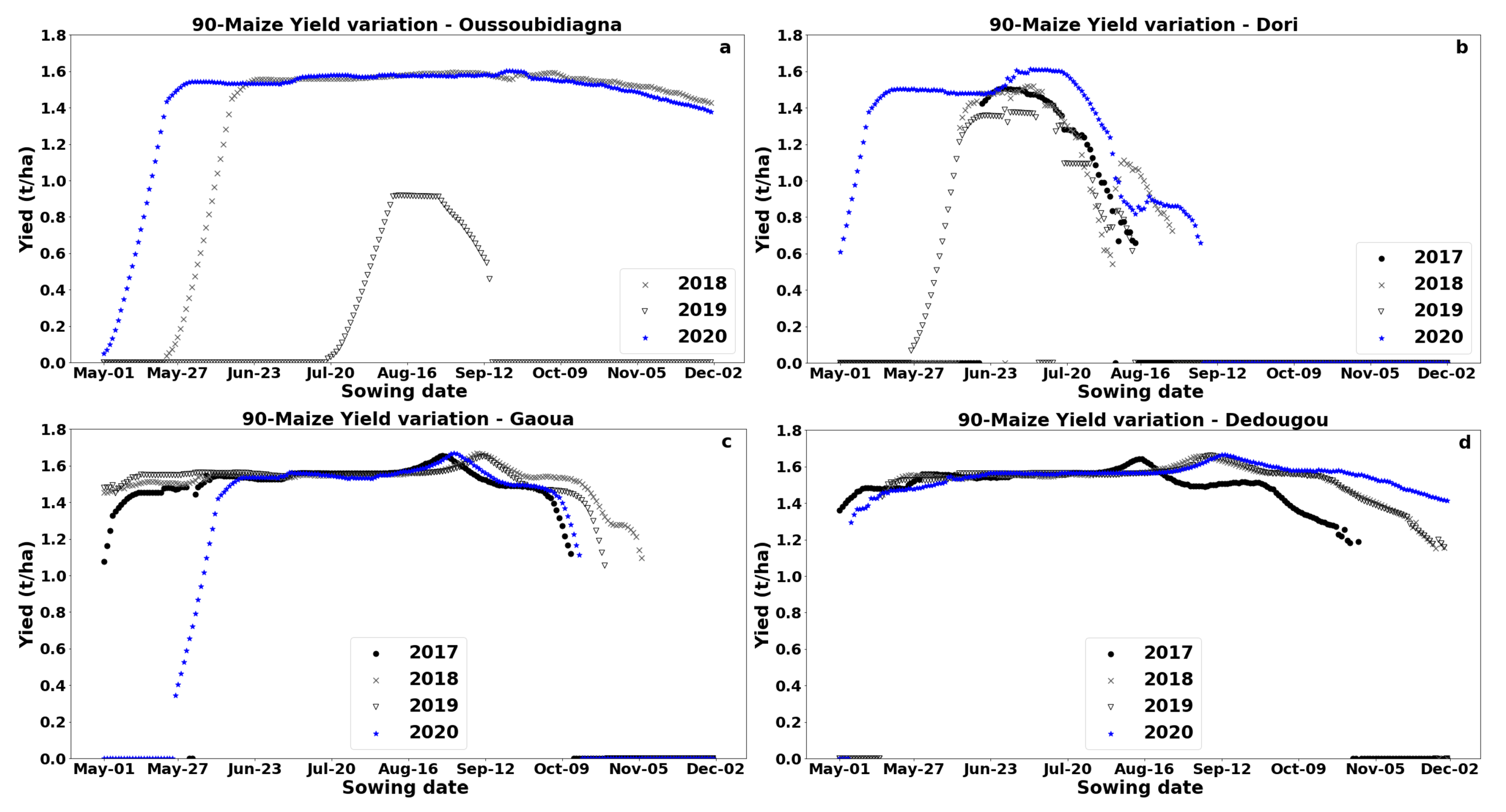

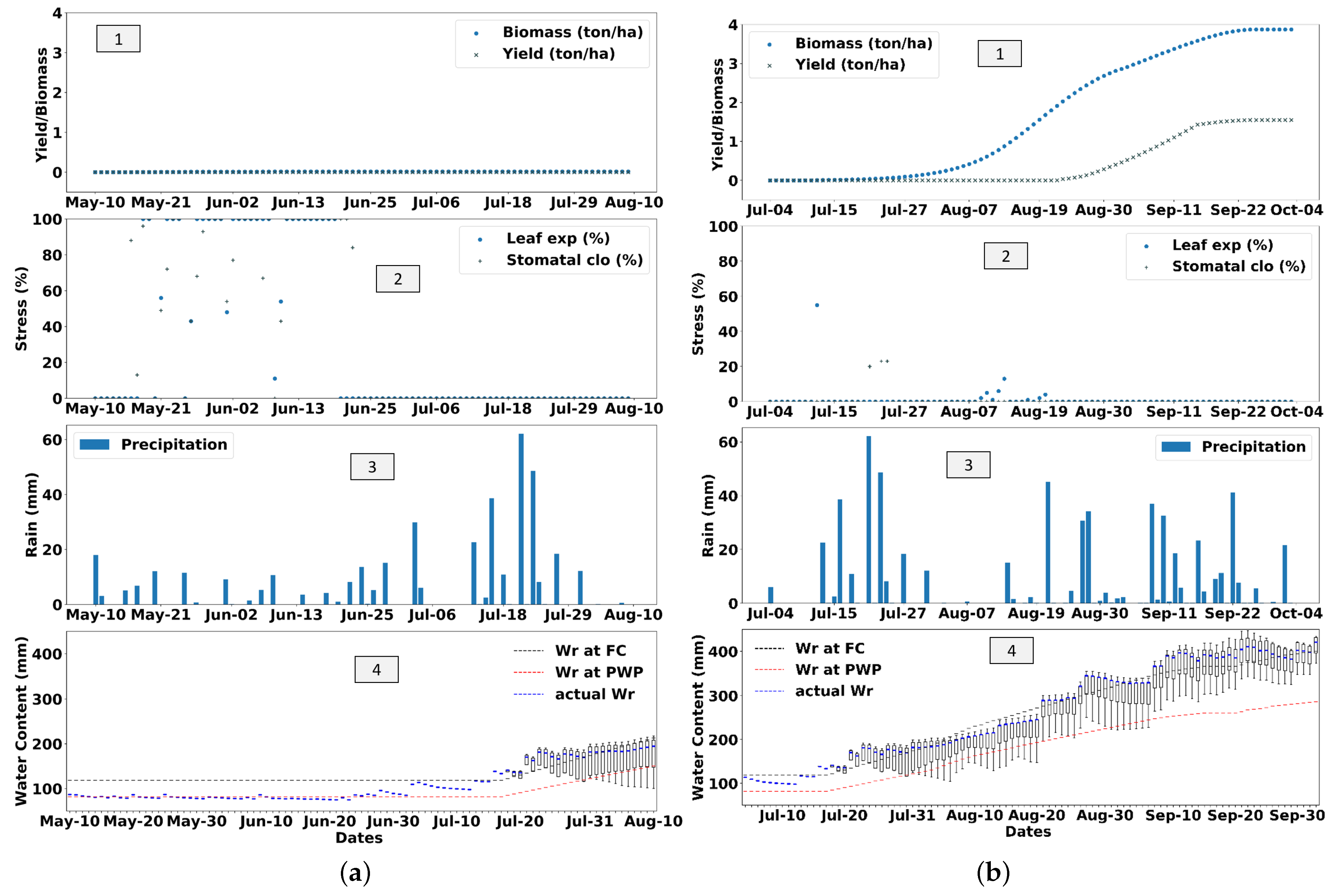
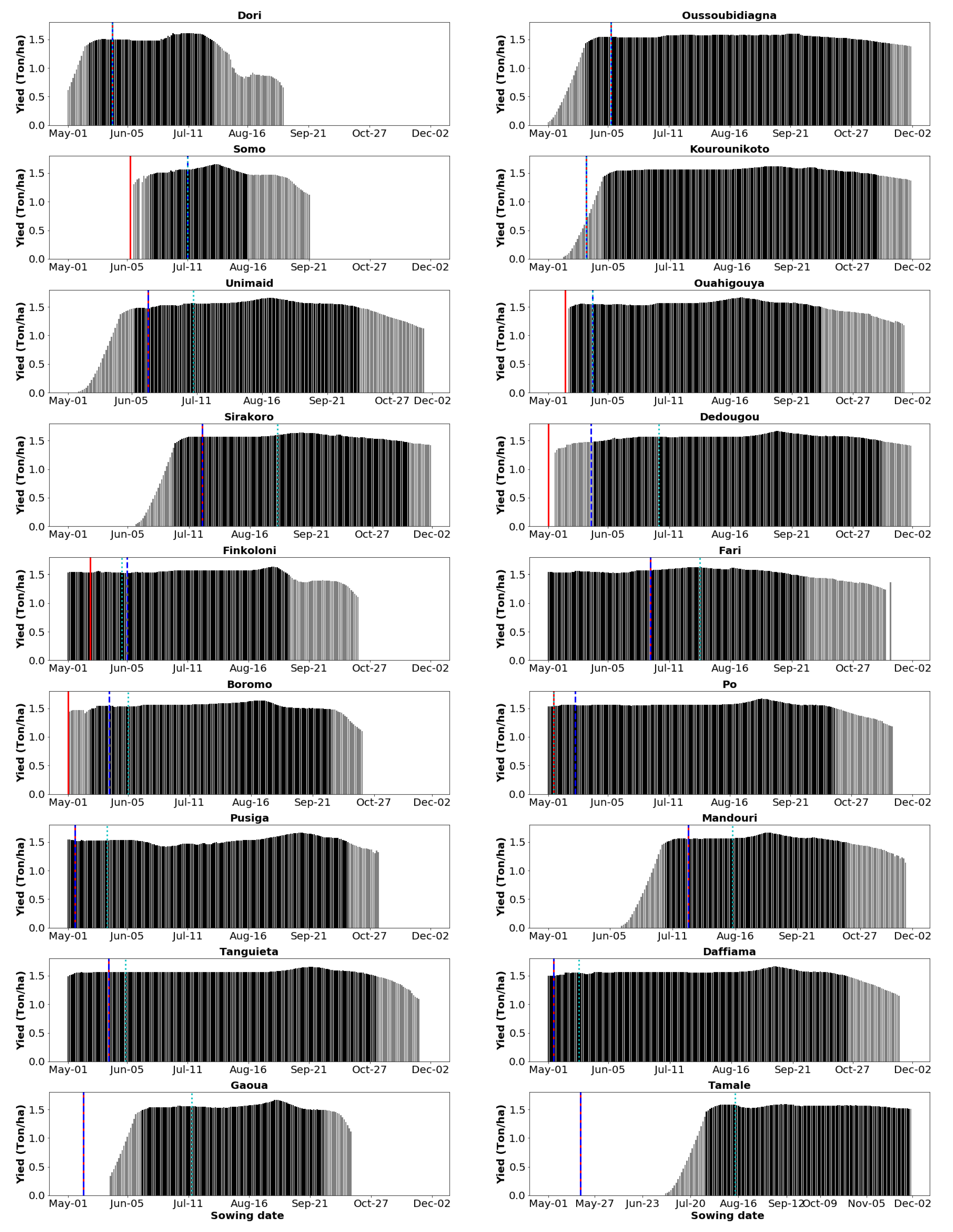
| Parameters Description | Value | Units or Meaning |
|---|---|---|
| Base temperature | 8 | C |
| Cut-off temperature | 30 | C |
| Canopy cover per seedling at 90% emergence (CC) | 6.5 | cm |
| Maximum canopy cover (CCx) | - | function of plant density |
| Canopy growth coefficient (CGC) | 1.3 | % increase per growing degree day (GDD) |
| Crop coefficient for transpiration at CC = 100% | 1.03 | full canopy transpiration relative to ET |
| Decline in crop coefficient after reaching CCx | 0.3 | % decline per day due to leaf aging |
| Canopy decline coefficient (CDC) at senescence | 1.06 | % decrease in CC relative to CCx per GDD |
| Water productivity (WP) | 33.7 | g(biomass) m, function of atmosphere CO |
| Leaf growth threshold p-upper | 0.14 | as fraction of TAW, above which leaf growth |
| is inhibited | ||
| Leaf growth threshold p-lower | 0.72 | leaf growth stops completely at p-lower value |
| Leaf growth stress coefficient curve shape | 2.9 | moderately convex curve |
| Stomatal conductance threshold p-upper | 0.69 | above this stomata begin to close |
| Stomatal stress coefficient curve shape | 6.0 | highly convex curve |
| Senescence stress coefficient p-upper | 0.69 | above this early canopy senescence begins |
| Senescence stress coefficient curve shape | 2.7 | moderately convex curve |
| Coefficient, inhibition of leaf growth on HI | 7.0 | HI increased by inhibition of leaf growth at anthesis |
| Coefficient, inhibition of stomata on HI | 3.0 | HI reduced by inhibition of stomata at anthesis |
| Parameters Description | Value | Units or | Source Values |
|---|---|---|---|
| Meaning | |||
| Time from sowing to maturity | 90 (Fixed) | Day | 97 [33] |
| Time from sowing to emergence | 6 | Day | 6 |
| Time from sowing to start of canopy senescence | 70 * | Day | 72 |
| Time from sowing to flowering | 48 * | Day | 52 [33] |
| Duration of flowering | 10 | Day | 10 |
| Time from sowing to maximum rooting depth | 80 * | Day | - |
| Maximum effective rooting depth, Z | 1.0 | meter | 1.0 |
| Reference harvest index, HI | 40 | % | 40 [35] |
| WP * reduction | 54 * | % | 53 |
| CCx under soil fertility stress | 45 * | % | 40–77 |
| Time to maximum canopy cover (CCx) | 56 | Day | Automated or |
| Building up of HI | 25 | Day | recommended by |
| Minimum effective rooting depth, Zn | 0.3 | meter | AquaCrop (FAO) |
| Plant population | 40,000 | Plant/ha | |
| N fertilizers levels | 0 (No input) | N kg/ha | Expert |
| Weeds management | 12 | % coverage | knowledge |
| 5 Recent Years | Sowing | Mean Actual Yield | Nearest Station | Simulated Yield | ||
|---|---|---|---|---|---|---|
| Country | Station | Available | Dates | [Range] (t/ha) | in TAHMO | for Sowing Dates (t/ha) |
| Bogande | 2007–2011 | 16–24 June | 0.99 [0.8–1.4] | Bogande | 0–1.5 | |
| Burkina | Boromo | 2007–2011 | 11–23 June | 1.46 [0.9–1.7] | Boromo | 1.3–1.5 |
| Faso | Dedougou | 2007–2011 | 02–16 June | 1.46 [0.9–1.8] | Dedougou | 1.4–1.5 |
| Gaoua | 2007–2011 | 02–08 June | 1.08 [0.7–1.4] | Gaoua | 1.5 | |
| Wa | 2007–2011 | 02–24 June | 1.3 [1.0–1.5] | Daffiama | 1.1–1.5 | |
| Ghana | Bolgatanga | 2007–2011 | 01–08 June | 1.39 [0.8–1.7] | Pusiga | 1.4–1.5 |
| Yendi | 2007–2011 | 01–04 June | 1.5 [1.2–1.8] | Tamale | 1.5 | |
| Nigeria | Maidu | 2006–2010 | 01–05 July | 1.1 [0.9–1.1] | Unimaid | 1.1–1.6 |
| Dag Dag | 2007–2011 | 02–07 July | 2.1 [0.7–3.9] | Oussoubidiagna | 0–1.5 | |
| Mali | Senou | 2007–2011 | 10–26 June | 1.9 [0.7–3.6] | Sirakoro | 1.4–1.5 |
| Koutiala | 2011–2013 | 11–25 May | 2.3 [2.2–2.5] | Finkoloni | 0–1.5 | |
| San | 2007–2011 | 11–17 June | 1.5 [0.3–2.5] | Somo | 0–1.5 |
Disclaimer/Publisher’s Note: The statements, opinions and data contained in all publications are solely those of the individual author(s) and contributor(s) and not of MDPI and/or the editor(s). MDPI and/or the editor(s) disclaim responsibility for any injury to people or property resulting from any ideas, methods, instructions or products referred to in the content. |
© 2023 by the authors. Licensee MDPI, Basel, Switzerland. This article is an open access article distributed under the terms and conditions of the Creative Commons Attribution (CC BY) license (https://creativecommons.org/licenses/by/4.0/).
Share and Cite
Agoungbome, S.M.D.; ten Veldhuis, M.-C.; van de Giesen, N. Optimal Sowing Windows under Rainfall Variability in Rainfed Agriculture in West Africa. Agronomy 2023, 13, 167. https://doi.org/10.3390/agronomy13010167
Agoungbome SMD, ten Veldhuis M-C, van de Giesen N. Optimal Sowing Windows under Rainfall Variability in Rainfed Agriculture in West Africa. Agronomy. 2023; 13(1):167. https://doi.org/10.3390/agronomy13010167
Chicago/Turabian StyleAgoungbome, Sehouevi Mawuton David, Marie-Claire ten Veldhuis, and Nick van de Giesen. 2023. "Optimal Sowing Windows under Rainfall Variability in Rainfed Agriculture in West Africa" Agronomy 13, no. 1: 167. https://doi.org/10.3390/agronomy13010167
APA StyleAgoungbome, S. M. D., ten Veldhuis, M.-C., & van de Giesen, N. (2023). Optimal Sowing Windows under Rainfall Variability in Rainfed Agriculture in West Africa. Agronomy, 13(1), 167. https://doi.org/10.3390/agronomy13010167








